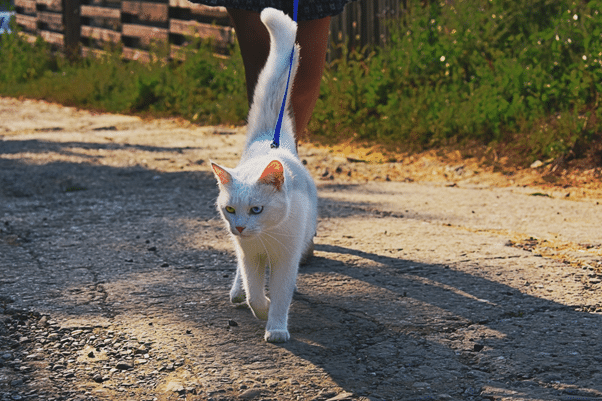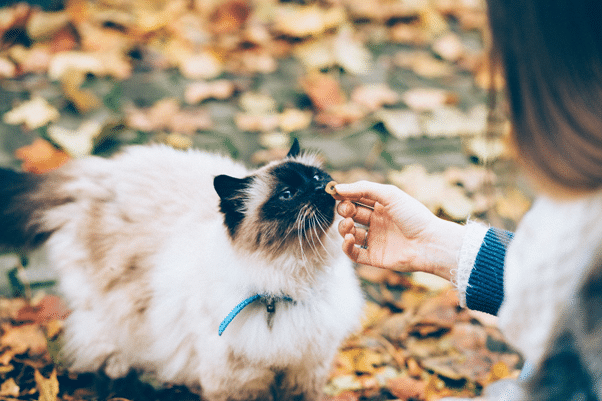

Training a Cat: The Ultimate Guide for Beginners
"If you’ve recently brought a furry kitten home, there’s no time to waste. It’s time to train the newest addition to your family. Take a look at this comprehensive guide on training a cat for beginners."
Most cat owners will probably agree with us when we say that it’s an absolute joy to have a furry companion to play with, especially after a long day’s work.
Cats make such wonderful pets; they are quiet, low maintenance, good for your health, and most importantly, excellent companions! You aren’t likely to have a single moment of boredom if you have a cute little cat in the house.
However, if you want to play ‘catch the ball’ with your cat, or want it to follow commands like roll over, jump, sit, high five, or stay, you need to train your pet properly.
Many people believe that training a cat is a challenge and that they don’t respond to training in the same ways that a dog would. However, with the right training methods, you can easily train your cat to develop good habits and follow your commands.
When training a cat, you want to start with very simple steps and familiarize your pet with basic acts like using a litter box, no biting or scratching, no jumping on the furniture, and following commands, among many other things.
To help you get started, take a look at this comprehensive guide on training a cat for beginners, which will help you create a special bond with your cat and get to know more about your feline friend.
The Basics of Cat Training
Cat training primarily begins with what you would like to teach your cat and what you want your pet to learn first.
There are a few essential things that you want to teach your cat right away, which include litter box training, behavior training, and target training, to name a few.
Litter Box Training

Cats are naturally really clean and tidy, with impressive waste-burying instincts. This makes litter training quite a quick and easy task; however, you need to establish clear boundaries with your pet and teach them to use the litter box to dispose of their waste.
Follow these steps when training a cat to use the litter box:
Take a clean litter box without any cover and place it in a confined area in your house, such as a spare room, for instance.
Leave your cat in the box along with proper access to food and water. At this point, you need to give your cat plenty of alone time.
Your cat isn’t going to learn to use the litter box right away, and it may go outside the box to relieve itself.
In such an instance, place the waste back into the litter box. While you might not want to do that, know that it’s an important step because the smell of the waste coming from the litter box is likely to encourage your pet to start using it.
After a few days, your cat will have learned to use the box to do their business regularly in the litter box. In case it hasn’t, place your cat in the litter box after every meal and use your finger to scratch the box to give them a demonstration of what they need to do. In time, they’ll pick up this habit.
Behavior Modification Training

Like humans, cats also experience all kinds of emotions, such as anxiety, hunger, frustration, and fear.
These can often result in undesirable behaviors in your cat that can affect both the owner and the pet animal.
The good news here, though, is that you can easily train your cat to modify and correct those unpleasant behaviors.
If your cat is displaying inappropriate behavior, the first thing you need to figure out is why your pet is behaving that way. For instance, if you find your cat clawing your bed or any other piece of furniture, it’s because, like many other animals, cats have this need to claw, and it’s a basic survival instinct for them. So, in such a situation, you want to train your cat to claw on acceptable objects and not your furniture, such as scratching posts or a toy, for example.
Howling
Ever gone to sleep only to be woken up by your cat howling outside your bedroom door?
Howling is a common vocalization issue in young kittens, and it mainly happens because they often tend to be active at night, or probably because they demand your attention. Increased meowing and crying can also occur alongside howling, and the first thing you need to do here is to rule out any medical problem.
One way to prevent nighttime vocalizations is to give your cat something to play with or be busy with while you sleep. Secondly, you should ensure that they are physically active during the day so that your pet is less active at night.
Scratching and Clawing
If your cat tends to scratch or claw your furniture excessively, you need to focus its attention on other objects that are claw-and-scratch-friendly.
The best thing you can give your cat is a scratching post. Some cats often let their owners know that they like a certain material or fabric more than others. If you’ve noticed your pet scratching or clawing a particular material, make sure that the scratching post offers the same material or texture.
Some popular textures for scratching posts include corrugated cardboard, rope, and carpeting.
Aggression
Cats are generally playful, and it’s actually a lot of fun to play with them, but there are times when they play a little too rough and resort to biting or scratching.
These behaviors are a sign of aggression, and they need to be corrected right away.
When training a cat to eliminate aggressive behaviors, you need to make it aware of the possible consequences. So, when you are playing with your cat, and it bites or scratches, one thing you can do is create a loud sound and startle them. Clap your hands together and start walking away, as a way to indicate that playtime is over.
Every time your cat gets rough or aggressive, startle them with a sudden sound and end the playtime. Your cat will eventually learn that biting or scratching will lead to serious consequences, so it needs to stop doing that.
Clicker Training
This is one of the fastest and most popular ways of training a cat to reinforce positive behavior in your pet.
It’s a positive reinforcement technique for cats that relies on a quiet sound, which acts as a reward for a desirable behavior that your cat performs.
As the name suggests, clicker training involves using a plastic clicker that you can easily get from your go-to pet store. In case you aren’t able to find one, you can use a retractable plastic pen that produces a click sound.
The idea here is to train your cat to associate the clicking sound with a desirable behavior that you want your pet to perform at all times. So, if there’s any behavior that you want to teach your cat, make sure to click immediately as soon as your pet performs the desired action.
Some beginners might struggle with it initially, but there’s a very easy way to go about it. Give your cat it’s favorite treat followed by a click as a way to gain its attention. Keep giving your pet tiny portions of food with the click to the point where your cat starts associating the clicking sound with the treat.
This way, your cat will finally begin to understand and learn that every bit of good behavior will earn them a click, so it will perform those behaviors more frequently.
Target Training
As the name implies, target training is all about encouraging your pet cat to go towards a particular object. This kind of training helps cats perform different types of desirable actions like going to bed on your command or walking into a carrier, for instance.
The idea here is to hold an item or an object in front of your cat and rewarding it with a treat when it touches it or sniffs it.
Keep moving the target object away, and each time, repeat what you did above. Eventually, your cat will associate positive behaviors with rewards and will listen to your commands to earn their fair share of treats.
Leash Training

Cats usually love the indoors, and the outdoor world tends to be a little scary and overwhelming for them. Teaching your pet to go outdoors and walking with a leash is an important part of cat training.
However, this step requires a whole lot of patience, time, effort, and love, so make sure to give your cat a bit of everything.
Before you attach a leash to your cat’s back, you first need to introduce the idea of a leash to your cat and help it get familiar with it.
You can begin by leaving the leash in areas where your cat spends most of its time, such as its favorite sleeping spot, or the feeding area, for instance. This will help your cat get used to the sight of a leash. The next thing you need to do is loosely drape the harness around its neck when giving the cat a treat and slowly and gradually move to secure the harness around its neck.
Do this for a few days and once you notice that your cat is comfortable with the harness, attach a leash to it. Allow the cat to move around and wander freely indoors with the leash and harness. Over the next few days, begin holding the leash and slowly move things outdoors.
Eventually, your cat will ease into it, and you will notice all its stress, apprehension, and fear vanish away. You can also introduce positive reinforcement during this process with lots of treats and appreciation.
Useful Tips to Help You Train a Cat Successfully
Training a cat is quite an extensive procedure that requires a lot of patience and love.
The ultimate goal is to teach your pet to become social and happy around others. At the same time, cat training is vital for the owner’s well-being as well.
After all, the better mannered your cat is, the stronger the bond you will share with your pet.
Here are a few useful tips for training a cat successfully so that both you and your furry kitty are pleased with the outcome and content around each other.
Start Small and Simple
The thought of training a cat is often super exciting for most beginners, and you might be tempted to teach your pet companion everything at once. However, the best way to go about it is to start small and simple and to give your cat one lesson at a time. Once your cat masters the first training session, move on to the next one, and so on.
If you want to be successful when it comes to cat training, you must take things slow with care and patience.
Keep the Training Sessions Short
Cats are known to have a short attention span, and if your training sessions are too long, they can easily get bored and disinterested.
It is best to keep each session short and well adapted to your cat’s interests and mood. At the same time, don’t give up if your pet isn’t picking up the pace and matching your speed because cats are different than human beings.
You need to give your pet time and space to absorb all the new things and learn one thing at a time.
Don’t Punish Your Cat
It is very easy for pet owners to become frustrated when things don’t go their way or when their pet doesn’t respond well to their commands.
However, never punish your cat for bad behavior because that is one of the worst things you can do during cat training. It will only trigger serious anxiety and stress in your cat if anything at all.
So, try to avoid punishments and use the technique of ‘distraction’ instead to eliminate bad behaviors. For instance, if your cat bites a lot, distract it with a sudden sharp sound every time it bites you. The cat will immediately stop biting, but the key here is to be consistent with the distracting sounds so that your pet knows which behavior it needs to avoid.
Start As Early As Possible
It is generally easier to train kittens than adult cats, so it’s best to start cat training as early as possible.
Begin the training process as soon as you bring home an adorable new kitty so that it’s fully trained within a short amount of time.
Rule Out Medical Problems
Often, training a cat is a challenge because your cat may be experiencing any medical problem that hinders the training process.
Always rule out medical possibilities by taking your cat to the vet and getting it examined. Once you know that your cat doesn’t have any health-related problem, you can easily resume the training sessions.
Reward Your Cat for Good Behavior

Positive reinforcement is one of the most useful and productive tricks in cat training. It does wonders when it comes to teaching a cat desirable and appropriate behavior.
Also, cats are known to respond extremely well to the whole system of positive reinforcement, so it only makes sense to use it to your advantage.
Every time your furry companion does something good, reward it with its favorite treat, some praise, a pat on the back, or appreciation. The clicker technique also applies here where you click each time your cat performs a good behavior.
The end goal here is to establish a connection between the behavior and the rewards so that your cat always behaves appropriately.
Show Love and Patience to Your Cat
There will be times when your cat doesn’t respond well to your training methods, but in any case, you need to treat it with love, care, and patience.
The outcome is worth all your hard work because you will have a pet cat that is well mannered, socially appropriate, content, and joyful around other people and other pets!
If you’ve recently brought a furry kitten home, it’s time for you to start the training sessions!
Discover how to create a joyful, healthy home for your pet.
Subscribe to your weekly rundown of practice, real life ideas and training tips straight to your inbox.


